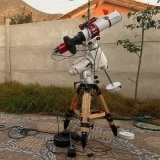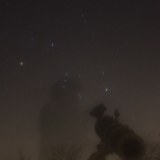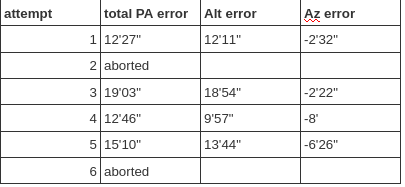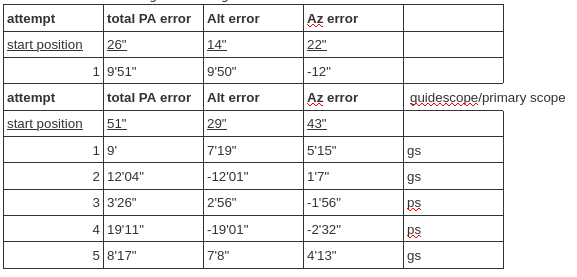INDI Library v2.0.7 is Released (01 Apr 2024)
Bi-monthly release with minor bug fixes and improvements
Inconsistent polar alignment results
Inconsistent polar alignment results was created by Paul
I am using the Skyguider Pro. I am using my guide scope to do the polar alignment with Ekos.
However, the results are not very consistent:
2 attempts did not succeed (might have been some clouds). Is this to be expected or is there a problem at my end ?
I am using kstars 3.5.2 on astroberry. Thanks.
Attachments:
Please Log in or Create an account to join the conversation.
- Wouter van Reeven
-

- Offline
- Supernova Explorer
-

- Posts: 1957
- Thank you received: 420
Replied by Wouter van Reeven on topic Inconsistent polar alignment results
Please Log in or Create an account to join the conversation.
Replied by Paul on topic Inconsistent polar alignment results
Guidecamera: ZWO ASI120MM mini
To answer your question: I just found it more convenient and less straining on my DSLR to use the guide camera. As the FOV of both are more or less comparable, I figured it was good idea idea.
Do you see any problems with this approach ?
Please Log in or Create an account to join the conversation.
- Val Chevalier
-

- Offline
- Premium Member
-

- Posts: 91
- Thank you received: 17
Replied by Val Chevalier on topic Inconsistent polar alignment results
Guiding with qhy 5L-II-m and ASI 178MC
HEQ5 pro with EqMod
Kstars Ekos on lenovo thinkcenter with Linux Mint 21
Please Log in or Create an account to join the conversation.
Replied by Paul on topic Inconsistent polar alignment results
Attachments:
Please Log in or Create an account to join the conversation.
Replied by Doug S on topic Inconsistent polar alignment results
a. Can you describe which flavor of PA you are using (direct polaris solve, or rotations at off-polaris sky positions)?
b. Have you tried to do a drift align with Phd2 for comparison?
I had a similar problem with the Ekos PA software on my Celestron CGX-L mount (rotations away from polaris approach). I also experienced variable results, and lost faith / gave up on that software. A PHD2 drift align solved this variability issue for me, so I suspect the implementation in Ekos (vs the mount or other possibilities). You might consider trying a PHD2 drift align, followed by running the Ekos PA routine (multiple times without driving either knob on the RA or DEC axis) to do the same variability analysis as you've already done. That will be a good data point for both quantifying / verifying that Ekos returns a similar numerical value as is reported by PHD2, AND verifying that Ekos returns the same value over multiple runs (since the knobs aren't changing)..... CS Doug
Please Log in or Create an account to join the conversation.
Replied by Paul on topic Inconsistent polar alignment results
In response to your questions:
a. I am using the EKOS polar alignment. I do the following: I try to get more or less polar aligned and then I use the procedure to take pictures at -60 degrees, 0 degrees and +60 degrees RA. I make the camera point straight ahead so declination is 90 degrees then I guess.
b. No, I have not but I plan to.
It's interesting you point out you had a similar experience with the Ekos PA. Can other people confirm this as well ? I will look at the PHD2 align when time and weather permit.
Thanks for your feedback.
Please Log in or Create an account to join the conversation.
- Jasem Mutlaq
-

- Online
- Administrator
-

Replied by Jasem Mutlaq on topic Inconsistent polar alignment results
Please Log in or Create an account to join the conversation.
Replied by Paul on topic Inconsistent polar alignment results
Note that I am doing a manual slew so by no means I am accurately getting 60 degrees every time. I am assuming this does not matter that much ? Or is this a wrong assumption ?
Please Log in or Create an account to join the conversation.
Replied by Doug S on topic Inconsistent polar alignment results
Edit: Also, to be fair to Ekos, please be careful with your PHD2 drift align! You need a good/flat (stable) drift over at least a few minutes! Also, if you don't have PEC sorted out for your mount, that could pose problems too. It's worth spending some time on PEC too to beat that component of variability down....
Please Log in or Create an account to join the conversation.
Replied by kobu on topic Inconsistent polar alignment results
However I then run PHD2 guiding assistant (setting FL as 128mm as well) and the error reported is much higher. In my last try after getting under 1’ error with Ekos i got 45’ of error in PHD2, which I think was correct as the drift was evident. I then run drift alignment in PHD2 and got under 3’ error so I was able to continue with my imaging session. Unfortunately I wasn’t able to run Ekos PA right after to get the error reported as it refused to plate solve any image (didn’t happen to me before)
Any ideas of what could be the issue? Maybe related to the FL not being set correctly?
In my next session I will definitely run PHD2 drift alignment first and then try Ekos PA, without touching the knobs but just trying different FLs to see if can get close results between both methods.
Thanks
Please Log in or Create an account to join the conversation.
Replied by Doug S on topic Inconsistent polar alignment results
Please Log in or Create an account to join the conversation.



